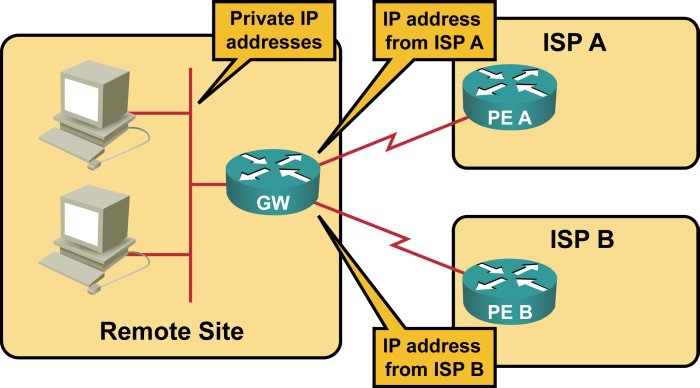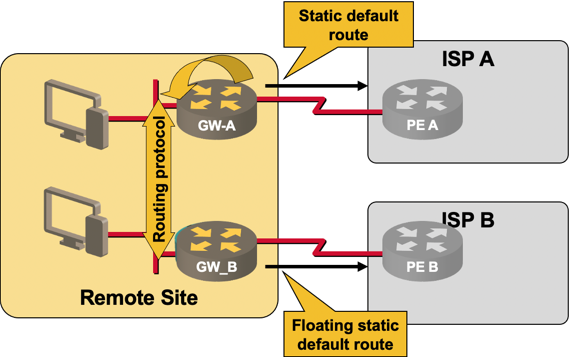… updated on Friday, November 20, 2020 07:00 UTC
Small Site Multihoming Tutorial
In 2007 and 2008, I wrote several articles covering small-site multihoming (a site connected to two ISPs without having its own public address space or running BGP).
Basics
A multihomed site is a customer site connected with (at least) two uplinks to one or more Internet Service Providers (ISP). Traditionally, a multihomed site needs its own provider independent (PI) public IP address space, has to run BGP with the upstream ISP and thus needs its own BGP autonomous system (AS) number.
These requirements are viable for central sites of enterprise networks or high-availability e-commerce solutions, but completely unrealistic if you want to multi-home a small site (or numerous remote sites of a single enterprise network).
Single-Router Small-Site Multihoming
Connecting a small site to multiple service providers can be extremely easy – you get two upstream links and two provider-assigned (PA) IP addresses (either static or dynamically assigned). Since each ISP will give you only a single IP address, you have to use private IP addresses on the LAN side of the router and perform Network Address Translation (NAT) on the gateway router.

IP addressing in a multihomed small site
Redundant Small-Site Multihoming
A redundant remote site is even simpler to implement. The addressing and routing requirements do not change (NAT from private to PA address space is performed on both gateway routers), but the routing becomes simpler: each gateway router has a single reliable static route and redistributes it into an intra-site dynamic routing protocol.
OSPF should be used as the intra-site routing protocol as its default route origination mechanisms require no route redistribution.

Default routing in a redundant multihomed site
Servers in Multihomed Small Site
If you want to deploy high-availability public servers within your network, you should implement proper multi-homing solution including BGP routing with the Service Providers. In most other cases, it’s better to use a decent hosting service.
However, if you want to deploy local mail server within your LAN or you have a special application that simply cannot be hosted anywhere else and you’re willing to accept less-than-perfect reliability and complex design, it’s possible to deploy servers in a small-site multihoming environment.

Servers in multi homed small site
From IPv4 to IPv6
Implementing a similar architecture in IPv6 is still a Mission Impossible, and although there have been many promises of how wonderful new architectures (like Homenet) will solve the problem, not much has been done in more than a decade; the only viable solution is still Network Prefix Translation. For more details, read these blog posts:
- Lack of IPv6 multihoming: the elephant in the room?
- Small-site multihoming in IPv6: mission impossible?
- IPv6 multihoming without NAT: the problem
- We just might need NAT66
- New in IPv6: The Next Chapter in IPv6 Multihoming Saga
- Are Provider-Independent IPv6 prefixes really global?
- IPv6 addressing: how wrong can you get it?
Revision History
- 2020-11-20
- Added IPv6 information
- 2025-03-20
- Migrated the Small Site Multihoming article

This was a great tutorial, I was doing a revisit to this tutorial and it seems the link to the actual tutorial is now broken. Had no luck with internet archive as well. Could you please post the actual document in the link?
Thank You
Thanks for the notice. As the target web site admits, "Well, we broke something."
I had no idea someone is still interested in that old stuff. Will try to resurrect it.